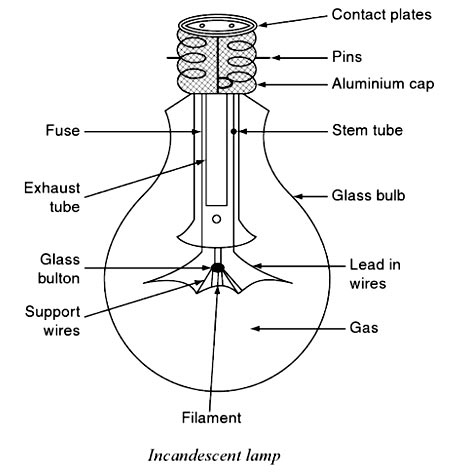Which gas is sometimes used in filament lamps?
Right Answer is:
Argon
SOLUTION
INCANDESCENT FILAMENT LAMP
These lamps are temperature-dependent sources. When an electric current is made to flow through a fine metallic wire, which is known as the filament, its temperature increases. At low temperatures, it emits only heat energy, but at very high temperatures, the metallic wire emits both heat and light energy. These incandescent lamps are also Blown as temperature radiators.
Choice of material for the filament
The materials commonly used as the filament for incandescent lamps are carbon, tantalum, tungsten, and osmium.
The materials used for the filament of the incandescent lamp have the following properties.
- The melting point of the filament material should be high.
- The temperature coefficient of the material should be low.
- It should be high resistive material.
- The material should possess good mechanical strength to withstand vibrations.
- The material should be ductile.
The color temperature of a normal filament lamp is typically between 2800 K and 3000 K. At the extremely high temperature of the filament, tungsten tends to evaporate. This leads to the familiar blackening of an incandescent lamp envelope. The evaporation of the tungsten filament can be reduced by filling the lamp envelope with a suitable gas that does not chemically attack the filament.
However, gases also cool the filament by conducting heat away from it, and they decrease lamp efficiency. The gas used must, therefore, be carefully chosen. It should adequately suppress tungsten evaporation without overcooling the filament. In addition, it should not readily pass an electric current, for otherwise arcing may occur which would destroy the lamp.

Argon and nitrogen are the gases most commonly used. Nitrogen will minimize the risk of arcing but will absorb more heat than argon. Argon is used by itself in general service lamps. A mixture of the two gases is used in incandescent lamps where the tendency for arcing is more likely, such as in projector lamps. In this case, the amount of nitrogen present is kept very small as little as 5% in order to obtain optimum lamp efficiency. Lamps filled with krypton gas have a longer life than argon and nitrogen lamps and cost more.
